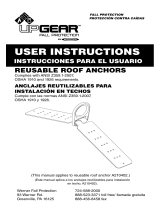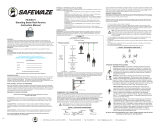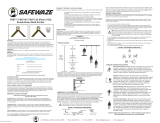Page is loading ...

1
WARNING: This product is part of a personal fall
arrest system. The user must read and follow the
manufacturer’s instructions for each component
or part of the complete system. These instructions
must be provided to the user of this equipment. The
user must read and understand these instructions
or have them explained to them before using this
equipment. Manufacturer’s instructions must be
followed for proper use and maintenance of this
product. Alterations or misuse of this product or
failure to follow instructions may result in serious
injury or death.
IMPORTANT: If you have questions on the use,
care, or suitability of this equipment for your
application, contact DBI‑SALA.
IMPORTANT: Record the product identication
information from the ID label in the inspection and
maintenance log in section 9.0 of this manual.
1.0 APPLICATIONS
1.1 PURPOSE: The Standing Seam Roof Anchor is designed for use as an anchorage connector for a personal
fall arrest system on sloped or at structural standing seam roofs, with seam spacing of 24, 30, 32, or
36 inches. The Standing Seam Roof Anchor is designed for use with DBI‑SALA Ultra‑Lok® Self Retracting
Lifelines only.
1.2 LIMITATIONS: Consider the following application limitations before using this equipment:
IMPORTANT: This anchor shall be installed and used under the supervision of a qualied person (see below for
denition) as part of a complete personal fall arrest system that maintains a safety factor of at least two.
QUALIFIED PERSON: An individual with a recognized degree or professional certicate, and extensive
knowledge and experience in the subject eld, who is capable of design, analysis, evaluation, and
specication in the subject work, project, or product. Refer to OSHA 1910.66, 1926.32, and 1926.502.
A. ROOF PANELS: The Standing Seam Roof Anchor must only be used on structural standing seam roof
panels that meet the geometric and load requirements specified in section 2.0.
B. CAPACITY: The Standing Seam Roof Anchor is designed for use by persons with a combined weight
(clothing, tools, etc.) of no more than 310 lbs. No more than one personal fall arrest system may be
connected to this equipment at one time.
C. FREE FALL: Personal fall arrest systems used with this equipment must be rigged to limit the free fall to
six feet or less. See the personal fall arrest system manufacturer’s instructions for more information.
D. FALL ARREST FORCES: The personal fall arrest system must limit fall arrest forces to 900 lbs.
© Copyright 2006, DB Industries, Inc.
Instructions for the following series
products Standing Seam Roof Anchor
Model Number: 2103675
USeR INSTRUCTION MANUAL STANdING SeAM ROOf ANChOR
This manual is intended to meet the Manufacturer’s Instructions, and should be used as part of
an employee training program as required by OSHA.
Figure 1 ‑ Standing Seam Roof Anchor

2
E. FALL CLEARANCE: There must be sufficient
clearance below the user to arrest a fall before the
user strikes the ground or other obstruction. The
clearance required is dependent on the following
factors:
• Elevation of the Standing Seam Roof Anchor
• Connecting subsystem length
• Deceleration distance
• Movement of the harness attachment element
• Worker’s height
• Free fall distance
See the personal fall arrest system manufacturer’s
instructions for more information.
F. SWING FALLS:
See Figure 2. Swing falls occur when
the user is at a location other than in‑line with the seams to which the Standing Seam Roof Anchor is
attached; or when the user is at a location other than perpendicular with the anchor and the seams to
which the Standing Seam Roof Anchor is attached to. The force of striking an object in a swing fall may
cause serious injury or death. Minimize swing falls by working as close to the anchorage point as possible.
Do not permit a swing fall if injury could occur. Swing falls will significantly increase the clearance required
when a self retracting lifeline is used.
G. ENVIRONMENTAL HAZARDS: Use of this equipment in areas with environmental hazards may require
additional precautions to prevent injury to the user or damage to the equipment. Hazards may include,
but are not limited to; heat, chemicals, corrosive environments, high voltage power lines, gases, moving
machinery, and sharp edges. Contact DBI‑SALA if you have questions about using this equipment where
environmental hazards exist.
H. TRAINING: This equipment must be installed and used by persons trained in its correct application and
use. See section 4.0.
1.3 APPLICABLE STANDARDS: Refer to applicable standards, including local, state, and federal requirements
for more information on personal fall arrest systems and associated components.
2.0 SYSTeM ReQUIReMeNTS
2.1 COMPATIBILITY OF COMPONENTS: DBI‑SALA equipment is designed for use with DBI‑SALA approved
components and subsystems only. Substitutions or replacements made with non‑approved components
or subsystems may jeopardize compatibility of equipment and may effect the safety and reliability of the
complete system.
2.2 COMPATIBILITY OF CONNECTORS: Connectors are considered to be compatible with connecting
elements when they have been designed to work together in such a way that their sizes and shapes do
not cause their gate mechanisms to inadvertently open regardless of how they become oriented. Contact
DBI‑SALA if you have any questions about compatibility.
Connectors (hooks, carabiners, and D‑rings) must be capable of supporting at least 5,000 lbs. (22kN).
Connectors must be compatible with the anchorage or other system components. Do not use equipment
that is not compatible. Non‑compatible connectors may unintentionally disengage. See Figure 3. Connectors
must be compatible in size, shape, and strength. Self locking snap hooks and carabiners are required by
ANSI Z359.1 and OSHA.
2.3 MAKING CONNECTIONS: Only use self‑locking snap hooks and carabiners with this equipment. Only use
connectors that are suitable to each application. Ensure all connections are compatible in size, shape and
strength. Do not use equipment that is not compatible. Ensure all connectors are fully closed and locked.
Figure 2 ‑ Swing Fall Hazard

3
DBI‑SALA connectors (snap hooks and carabiners) are designed to be used only as specied in each
product’s user’s instructions. See Figure 4 for inappropriate connections. DBI‑SALA snap hooks and
carabiners should not be connected:
A. To a D‑ring to which another connector is attached.
B. In a manner that would result in a load on the gate.
NOTe: Large throat opening snap hooks should not be connected to standard size D‑rings or similar objects
which will result in a load on the gate if the hook or D‑ring twists or rotates. Large throat snap hooks are
designed for use on xed structural elements such as rebar or cross members that are not shaped in a way that
can capture the gate of the hook.
C. In a false engagement, where features that protrude from the snap hook or carabiner catch on the
anchor and without visual confirmation seems to be fully engaged to the anchor point.
D. To each other.
E. Directly to webbing or
rope lanyard or tie‑back
(unless the manufacturer’s
instructions for both the
lanyard and connector
specifically allows such a
connection).
F. To any object which is
shaped or dimensioned
such that the snap hook or
carabiner will not close and
lock, or that roll‑out could
occur.
2.4 PERSONAL FALL ARREST
SYSTEM: Personal fall arrest
systems used with this
equipment must meet applicable state, federal, and OSHA requirements. A full body harness and DBI‑SALA
Ultra‑Lok Self Retracting Lifeline must be used with the Standing Seam Roof Anchor.
If the connecting element that a snap hook (shown) or carabiner attaches to is undersized or irregular in
shape, a situation could occur where the connecting element applies a force to the gate of the snap hook
or carabiner. This force may cause the gate (of either a self‑locking or a non‑locking snap hook) to open,
allowing the snap hook or carabiner to disengage from the connecting point.
1. Force is applied to the
snap hook.
2. The gate presses against the
connecting ring.
3. The gate opens allowing the
snap hook to slip off.
FIGURE 3 - UNINTENTIONAL DISENGAGEMENT (ROLL-OUT)
Small ring
or other
non‑compatibly
shaped element
FIGURE 4 - INAPPROPRIATE CONNECTIONS

4
2.5 SEAM REQUIREMENTS: The Standing Seam Roof Anchor
must be attached to the seam as shown in Figure 5. The hook
side of the seam clamp must hook under the seam for proper
attachment.
WARNING: The seam must be compatible with the seam clamp. Do
not use the Standing Seam Roof Anchor if you are unable to attach to
the seam as shown in Figure 5. Failure to attach the Standing Seam
Roof Anchor correctly may result in serious injury or death.
2.6 ANCHORAGE STRENGTH: From OSHA 1926.500 and 1910.66:
Anchorages used for attachment of a personal fall arrest system
(PFAS) shall be independent of any anchorage being used to
support or suspend platforms, and must support at least 5,000
lbs. per user attached; or be designed, installed, and used as part
of a complete PFAS which maintains a safety factor of at least
two, and is supervised by a qualied person.
WARNING: Do not use the Standing Seam Roof Anchor on
architectural standing seam roof panels. Architectural roof panels do
not have the strength required for fall arrest.
2.7 MULTIPLE UNITS: When attaching multiple Standing Seam Roof
Anchors on one roof follow the guidelines shown in Figure 6. Two
or more Standing Seam Roof Anchors must not apply loads to a
single panel fastener.
3.0 INSTALLATION ANd USe
WARNING: Do not alter or intentionally misuse this equipment. Consult DBI‑SALA when using this equipment
in combination with components or subsystems other than those described in this manual. Some subsystem
and component combinations may interfere with the operation of this equipment. Use caution when using this
equipment around moving machinery, electrical hazards, chemical hazards, and sharp edges.
WARNING: Consult your doctor if there is reason to doubt your tness to safely absorb the shock from a fall
arrest. Age and tness seriously affect a worker’s ability to withstand falls.
Pregnant women and minors must not
use this equipment.
3.1 BEFORE EACH USE OF THIS EQUIPMENT INSPECT ACCORDING TO SECTION 5.0 OF THIS MANUAL.
3.2 PLAN YOUR SYSTEM BEFORE INSTALLATION. CONSIDER ALL FACTORS THAT WILL AFFECT YOUR
SAFETY DURING USE OF THIS EQUIPMENT. CONSIDER THE FOLLOWING WHEN PLANNING YOUR
SYSTEM:
A. ANCHORAGE: Select an anchorage that meets the requirements specified in sections 2.5 and 2.6.
B. SHARP EDGES: Avoid working where the system components may be in contact with, or abrade
against, unprotected sharp edges.
C. RESCUE: The employer must have a rescue plan when using this equipment. The employer must have
the ability to perform a rescue quickly and safely.
3.3 INSTALLATION:
Step 1. Adjust the legs to the required seam spacing (24, 30, 32 or 36 inches) by removing the detent pins
and sliding the two inner legs to the appropriate seam dimension. Reinstall the detent pins. Ensure
the detent pins are inserted through the inner and outer leg adjustment holes and are locked into
position before use. See Figure 7.
Step 2. Clamp the Standing Seam Roof Anchor to the roof panel seams at four places as shown in Figures 5
and 8. Torque the four seam clamp bolts to 75 ft‑lbs.
WARNING: The seam clamp bolts must be torqued to 75 ft‑lbs. to the ensure proper attachment to the roof
panel. The seam clamp bolts must be retorqued daily. Failure to properly torque the bolts may result in serious
injury or death.
Figure 5 ‑ Attaching to the Seam

5
Step 3. Attach the Ultra‑Lok® Self Retracting Lifeline to the Swivel Bracket on the Standing Seam Roof
Anchor as shown in Figure 9 using the hardware provided. Use the appropriate mounting holes for
the self retracting lifeline model.
3.4 USE: Connect the Ultra‑Lok® Self Retracting Lifeline to the full body harness according to the self retracting
lifeline and the full body harness user instruction manuals. Retorque the seam clamp bolts daily as shown in
Figure 8.
WARNING: Read and follow the user instruction manuals included with the self retracting lifeline and the full
body harness.
Figure 6 ‑ Attaching Multiple Standing Seam Roof Anchors

6
Figure 8 ‑ Clamping Standing Seam Roof Anchor to Roof Panel
Figure 7 ‑ Adjusting Legs

7
Figure 9 ‑ Attaching Self Retracting Lifeline to Standing Seam Roof Anchor
4.0 TRAINING
4.1 It is the responsibility of all users of this equipment to understand these instructions, and to be trained
in
the correct installation, use, and maintenance of this equipment. These individuals must be aware of the
consequences of improper installation or use of this equipment. This user manual is not a substitute for a
comprehensive training program. Training must be provided on a periodic basis to ensure prociency of the users.
WARNING: Training must be conducted without exposing the trainee to a fall hazard. Training should be
repeated on a periodic basis.
5.0 INSPeCTION
5.1 FREQUENCY:
• BeforeEachUse inspect the Standing Seam Roof Anchor according to sections 5.2 and 5.3.
Retorque the seam clamp bolts daily.
• FormalInspection:A formal inspection of the Standing Seam Roof Anchor must be performed at
least annually by a competent person other than the user. The frequency of formal inspections should be
based on conditions of use or exposure. See sections 5.2 and 5.3. Record the inspection results in the
inspection and maintenance log in section 9.0.
WARNING: If this equipment has been subjected to fall arrest forces remove from service and destroy, or return
to an authorized service center for repair.
5.2 INSPECTION STEPS:
Step 1. Inspect the entire unit for damage or excessive corrosion. Look for cracks or wear that may affect
the strength or operation of the unit.
Step 2. Ensure the swivel bracket is free of damage, corrosion, cracks, deformities, or excessive wear.
Ensure the self retracting lifeline is securely attached to the swivel bracket. The swivel bracket must
swivel 360 degrees.
Step 3. Inspect the inner and outer legs. The legs must not be bent or damaged. The inner legs must slide
freely into the outer legs.
Step 4. Inspect the detent pins. The detent pins must not be bent or damaged. The detent pins must
securely lock in place.

8
Step 5. Inspect the seam clamps. The seam clamps must not be bent or damaged.
Step 6. Inspect the self retracting lifeline and the full body harness according to the manufacturer’s user
instruction manuals.
5.3 If the inspection reveals an unsafe or defective condition, remove the Standing Seam Roof Anchor from
service and destroy, or return it to an authorized service center for repair.
IMPORTANT: Only DBI‑SALA or parties authorized in writing may make repairs to this equipment.
6.0 MAINTeNANCe
6.1 CLEAN THE STANDING SEAM ROOF ANCHOR WITH MILD SOAP AND WATER. EXCESSIVE BUILD-
UP OF DIRT MAY PREVENT THE SWIVEL BRACKET FROM SWIVELLING.
7.0 SPeCIfICATIONS
7.1 MATERIALS:
INNER AND OUTER LEGS: Telescopic steel tubing
SWIVEL BRACKET: Hot rolled steel
ANGLES: ASTM A36 steel
SEAM CLAMPS: Hot rolled steel
7.2 DIMENSIONS:

9
Warning Label
ID Label
8.0 LABeLING
8.1 THESE LABELS MUST BE PRESENT AND FULLY LEGIBLE:

10
INSPECTION DATE INSPECTION ITEMS
NOTED
CORRECTIVE ACTION MAINTENANCE
PERFORMED
Approved by:
Approved by:
Approved by:
Approved by:
Approved by:
Approved by:
Approved by:
Approved by:
Approved by:
Approved by:
Approved by:
Approved by:
Approved by:
Approved by:
Approved by:
Approved by:
Approved by:
Approved by:
Approved by:
9.0 INSPeCTION ANd MAINTeNANCe LOG
DATE OF MANUFACTURE
MODEL NUMBER
DATE OF PURCHASE

11
INSPECTION DATE INSPECTION ITEMS
NOTED
CORRECTIVE ACTION MAINTENANCE
PERFORMED
Approved by:
Approved by:
Approved by:
Approved by:
Approved by:
Approved by:
Approved by:
Approved by:
Approved by:
Approved by:
Approved by:
Approved by:
Approved by:
Approved by:
Approved by:
Approved by:
Approved by:
Approved by:
Approved by:
9.0 INSPeCTION ANd MAINTeNANCe LOG
DATE OF MANUFACTURE
MODEL NUMBER
DATE OF PURCHASE

12
USA Canada
3833 SALA Way 260 Export Boulevard
Red Wing, MN 55066‑5005 Mississauga, Ontario L5S 1Y9
Toll Free: 800‑328‑6146 Toll Free: 800‑387‑7484
Phone: (651) 388‑8282 Phone: (905) 795‑9333
Fax: (651) 388‑5065 Fax: (905) 795‑8777
www.capitalsafety.com www.capitalsafety.com
This manual is available for download at www.capitalsafety.com.
Form: 5902111
Rev: D
I S O
9 0 0 1
Certicate No. FM 39709
/




